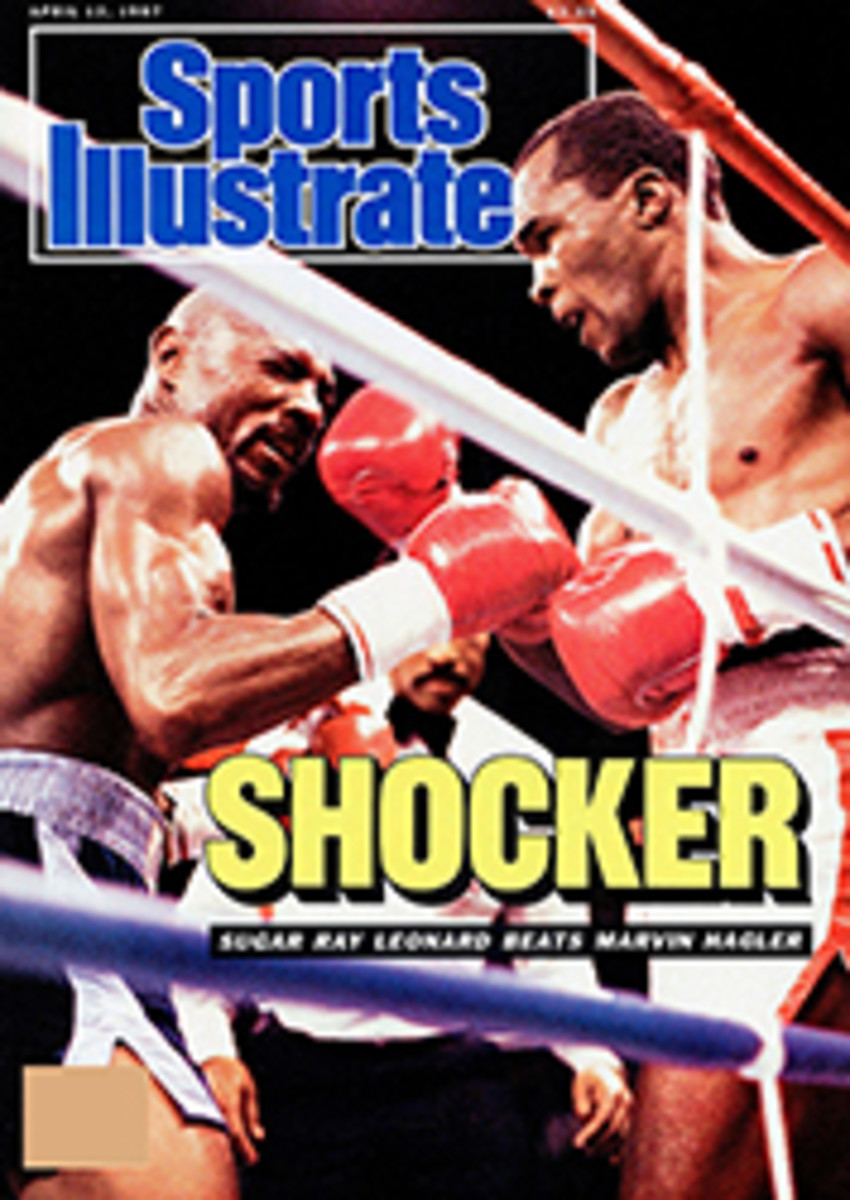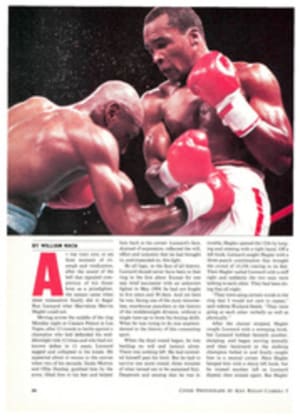
RIGHT ON TARGET FOR STRIKES AND RINGERS
Jackie Joyner's basketball career at UCLA is over. And it has been years since John Elway thumbed his nose at George Steinbrenner and months since Bo Jackson spurned the Tampa Bay bucks. That leaves Walter Ray Williams Jr. as perhaps the top two-sport athlete in the nation.
If you haven't heard of Williams, don't be surprised. You won't find his name in your book of "Who's Who in Athletics." His sports are bowling and horseshoes, two long-standing passions of middle America, blue-collar activities better illustrated by Norman Rockwell than LeRoy Neiman.
Both games require accuracy and. Williams says. "The arm swing [in each! is similar." But the games are also different in that horseshoes plays the role of country cousin to the more urban pastime of bowling.
Williams, who is 27, does not fit the stereotypes of either game, being neither a hayseed nor a city slicker. "When people hear that I pitch shoes and that my nickname is Deadeye," he says, "they expect to meet some 60-year-old guy." Others hear horseshoes and the double first name, Walter Ray, and they assume he hails from the rural South. Williams is from California, born in San Jose and now living in Stockton. "I didn't grow up on a farm and I don't even like horses." he says.
As for bowling, at 6'2" and 160 pounds, Williams hardly shares the bowling-ball physique of America's most famous participants, Ralph Kramden and Fred Flintstone. And unlike either of those gentlemen, Williams has a physics degree from Cal Poly-Pomona and is more likely to be found in his motel room designing a horseshoe scoring program on his computer than in a bar knocking back a few cold ones.
When Williams packed up his five world horseshoe titles and joined the Professional Bowlers Association in 1980 there were many skeptics who doubted his motives, not the least of whom were his fellow bowlers.
"I'm sure all of us felt he didn't have a chance," says Dick Weber, a Hall of Fame bowler. "He has a very unorthodox style. He's herky-jerky going to the foul line. But he does one thing right: He gets the ball in the pocket."
And the ball in the pocket has meant money in the pocket. Last year Williams led the tour with $145,550 in earnings and nine top-five finishes. He won three tournaments and finished third in average with 213.8 pins a game. Three months ago he was named 1986 Bowler of the Year by both his fellow bowlers and the nation's bowling writers. This year he's doing well again, having beaten Marshall Holman in February to win the $150,000 PBA tournament in Miami. Through the middle of March he had won $51,410 and was fifth on the PBA money list.
Laurels and triumphs notwithstanding. Williams would never have become a serious bowler if he could have earned a living pitching horseshoes. But in 10 years of professional pitching he has made only $30,000, which is a good deal less than Dwight Gooden earns per start. So, after Williams won his first men's world horseshoe title in 1978, he turned his focus to bowling, a sport in which he had dabbled with above average success in high school.
In the summer of '79, the confident neophyte boosted his average from 170 to 200. "They made the lanes easier [by changing the oil pattern]," Williams says, "and I improved." A year later he joined the PBA and played in local and regional events. He still needed time, however, to grind out his senior thesis, a 60-page opus entitled "The Physics of a Bowling Ball." The paper received an 'A', but Williams cautions, "It's not going to make anyone a better bowler."
In 1983, with college behind him, Williams joined the tour full-time and averaged $40,000 a year for the next three years. Now he is leaving his mark—granted, a contradiction of bowling terms—as the first two-sport star in the history of the tour. He is a crowd favorite and, says veteran Guppy Troup, "He knows how to play the audience as well as Marshall and I."
His name—and he insists on Walter Ray Williams Jr.—is one of the biggest, if not the longest, in bowling. Williams has also found that his name carries a price. It has cost him as much as $9.50 to have the 19 letters of his name (at 50¬¨¬®¬¨¢ a letter) stitched onto his bowling shirts. It is also one of the biggest names in the horseshoe-pitching world, where it has raised eyebrows and expectations ever since Williams competed in his first world tournament 17 years ago.
It was there that the 10-year-old Williams had the nickname Deadeye literally pinned on him by a statistician who put it on a piece of paper and pinned it to his back after he pitched 45 ringers out of 50 shoes in one round. The next year Williams won his first world junior (under-17) title with a then record 86.3% ringers and made the first of two appearances in this magazine's FACES IN THE CROWD section. The next year he won a second title with 89.2% ringers.
Games of accuracy are frequently a battle of nerves as much as a test of skill. Bowlers and horseshoe pitchers, like golfers, get the yips. All live in fear of choking. For Williams pressure is an old acquaintance. Pressure was being called Deadeye. Pressure was throwing horseshoes on The Dick Cavett Show at age 11. Pressure was winning his last junior title pitching—by choice—from the men's distance, 40 feet, while everyone else pitched from 30 feet.
Above all, pressure was everyone expecting him to be the best in the world when it was sometimes a struggle to be the best in his own backyard. Twice Walter Ray lost the world junior title to his brother Jeff. Horseshoes are pitched with a cancellation scoring system, whereby a pitcher can negate an opponent's ringer by throwing one on top of it and leaving the score unchanged. In general, the better the pitching, the longer the game. Fifty shoes is normal, 200 virtually unheard of. Walter Ray and Jeff once pitched a 208-shoe game that Jeff finally won.
Williams does not take kindly to losing, even to his brother. But it is this drive, combined with his competitive steel, that has bridged his considerable experience gap on the bowling tour.
"He's a fierce competitor," Weber says. "He has a little temper, which is good. He lets it out. I've always been an advocate of temper—within reason."
But Williams has not always let his temper be constrained by reason. He has flung horseshoes, kicked backstops, muttered obscenities.
"I had a McEnroe reputation in horseshoes," Williams says. "I got a sportsmanship award once at a regional bowling tournament, and the horseshoe pitchers I told wouldn't believe it."
"People didn't like his attitude," says Jesse Gonzales, the California horseshoe champion until he was beaten by Williams in '86. "It was poor sportsmanship. He's doing a lot better since he started bowling. He told me, 'Jesse, you have to hold your temper or it costs you money.' "
Gonzales has been the benefactor of another side of Williams's temperament—the generous side. Last year Williams heard that Gonzales couldn't afford to attend the world championship in Ainsworth, Neb. "He was very concerned," Gonzales recalls. "He asked, 'Would you go if I sponsored you?' 'What?!' I had to look twice." With Williams's backing, Gonzales finished sixth and made $600.
If bowling has taught Williams some manners, it has also brought him belated and perhaps begrudging respect from his fellow pitchers. One night last summer during the world championships in Ainsworth, Williams agreed to put on a bowling exhibition at Wurth's Cafe-Gas-Bowl. Spectators jammed the little eight-lane alley, spilling out the front door into the parking lot. People stood on chairs and pressed up against the table shuffleboard game to watch Williams bowl. And though his competition was strictly local, the crowd wasn't. Dozens and dozens of horseshoe pitchers had abandoned the world championships to watch one of their own.
"It will be," owner Vern Wurth said, "the biggest feather in my cap for as long as I live."
Why? Because seldom do people in Ainsworth or even parts less remote get to watch an athlete who has conquered two sports, even if those sports are such unheralded American classics as bowling and horseshoes.
TWO PHOTOS
JACQUELINE DUVOISIN
Pro bowlers say that Williams's arm swing, grooved from pitching shoes, is unorthodox.
PHOTO
JACQUELINE DUVOISIN
As the back of his shirt attests, Williams has made a name for himself in both sports.

